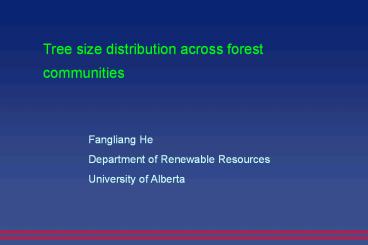Tree size distribution across forest communities - PowerPoint PPT Presentation
1 / 22
Title:
Tree size distribution across forest communities
Description:
Tree size distribution across forest communities Fangliang He Department of Renewable Resources University of Alberta Tradeoffs in mechanisms: shade tolerant vs ... – PowerPoint PPT presentation
Number of Views:115
Avg rating:3.0/5.0
Title: Tree size distribution across forest communities
1
Tree size distribution across forest communities
Fangliang He Department of Renewable
Resources University of Alberta
2
Trade-offs in ecology
- Tradeoffs in mechanisms shade tolerant vs
intolerant, specialist vs generalist, r vs k
species, colonization vs competition - Tradeoffs in structure rare vs abundant, small
vs large, low vs tall
3
Tree size distribution number versus size
With few exceptions forest communities have many
small trees but a few large trees. The reverse
relationship between the number of trees and size
may result from many mechanisms self-thinning
(competition-density effect), growth-mortality
tradeoff, allometric scaling, statistical
processes, self-organized criticality, etc.
4
-3/2 thinning rule
5
-4/3 thinning rule (allometric scaling of energy
in a saturated ecosystem)
6
Self-organized criticality or statistical
properties?
Self-organized critical phenomena is exhibited by
driven systems which reach a critical state by
their intrinsic dynamics, independently of the
value of any control parameter. The archetype of
a self-organized critical system is a sand pile.
Sand is slowly dropped onto a surface, forming a
pile. As the pile grows, avalanches occur which
carry sand from the top to the bottom of the
pile. At least in model systems, the slope of the
pile becomes independent of the rate at which the
system is driven by dropping sand. This is the
(self-organized) critical slope.
7
Self-organized criticality or statistical
properties?
Reed Hughes (JTB 2002)
Chu Adami (PNAS 1999)
8
Growth-mortality dynamics
A forward Kolmogorov equation
where f(x) is the number of stems in size class
x, g(x) is size dependent mean growth rate, m(x)
is mortality rate. (The variance term can be
ignored.)
Probability density function of size distribution
Kohyama et al. J. Ecol. 91797-806 (2003) Coomes
et al. Ecol. Lett. 6980-989 (2003)
9
Growth-mortality dynamics
Exponential distribution
Weibull distribution
Pareto distribution
(c-b1)
Muller-Landau et al. Ecol. Lett. 9589-602 (2005)
10
Exponential
Weibull
Pareto
11
The derivation of tree size distribution based on
the forward Kolmogorov equation requires an
equilibrium state of the growth and mortality
dynamics and total population size to be
stable. Next we take a different approach to
show that these conditions are not necessary. The
new approach considers deterministic growth but
stochastic colonization/mortality.
12
Exponential growth with a random harvest process
The power-law model
This model can arise from exponential growth with
a random harvest (killing) process
Exponential growth
Harvest process
13
Exponential growth
Harvest process
14
Weibull distribution the most widely used tree
size model
Power growth
Harvest process
15
Weibull distribution interpretation
- An even-aged community where all trees have the
same growth rate, but different (exponential)
harvesting time. Equivalent to observing a single
tree at different time. - An uneven-aged community where trees have the
same growth rate, but the mortality and
colonization is a stochastic process following an
exponential distribution.
16
The Gentry data (226 sites)
17
How well the Weibull distribution works?
18
Test the assumption of the power law growth rate?
Power growth
Weibull
19
Barro Colorado Island
20
The Panama data
21
Average age of the trees in Panama
a
Empirical estimate of the age of BCI trees 30-50
yrs
22
Summary
- There is no universal law governing tree size
distribution. Tree size distribution is more
realistically modeled by mortality-growth
dynamics. - Weibull distribution of tree size arises from
deterministic growth (with trees having the same
growth rate) but stochastic mortality and
colonization following an exponential
distribution. - Enquist et al. metabolic-based power-law model is
a special case of the mortality-growth dynamics.






























